栈(Stack)
1.栈也是用来存储逻辑关系为 “一对一” 数据的线性存储结构
2.栈是一种只能从表的一端存取数据且遵循 “先进后出” 原则的线性存储结构。
3.栈的开口端被称为栈顶;相应地,封口端被称为栈底。因此,栈顶元素指的就是距离栈顶最近的元素。**
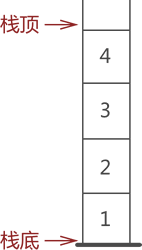
进栈(Push)和出栈(Pop)
1.向栈中添加元素,此过程被称为”进栈”
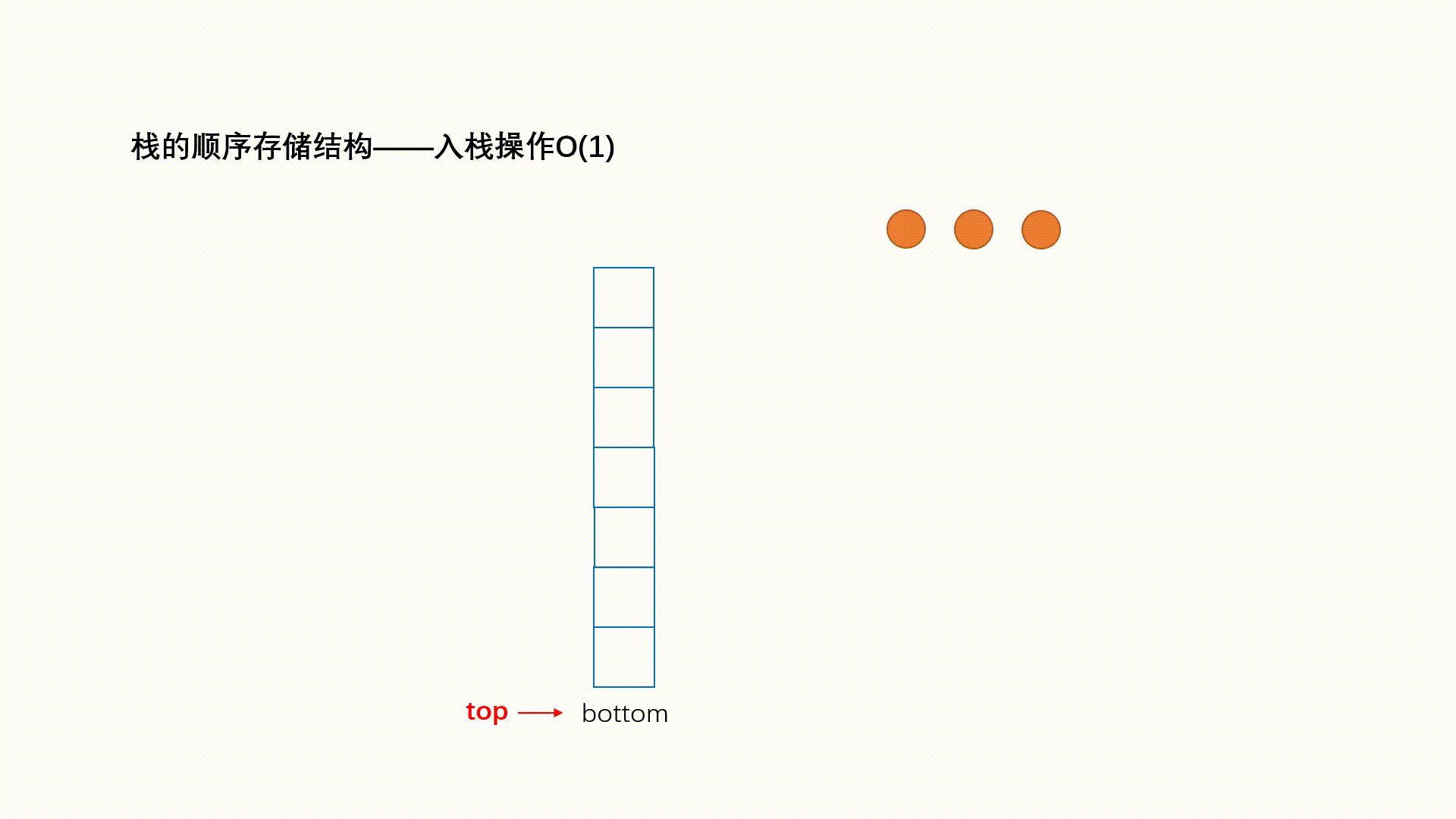
2.从栈中提取出指定元素,此过程被称为”出栈”
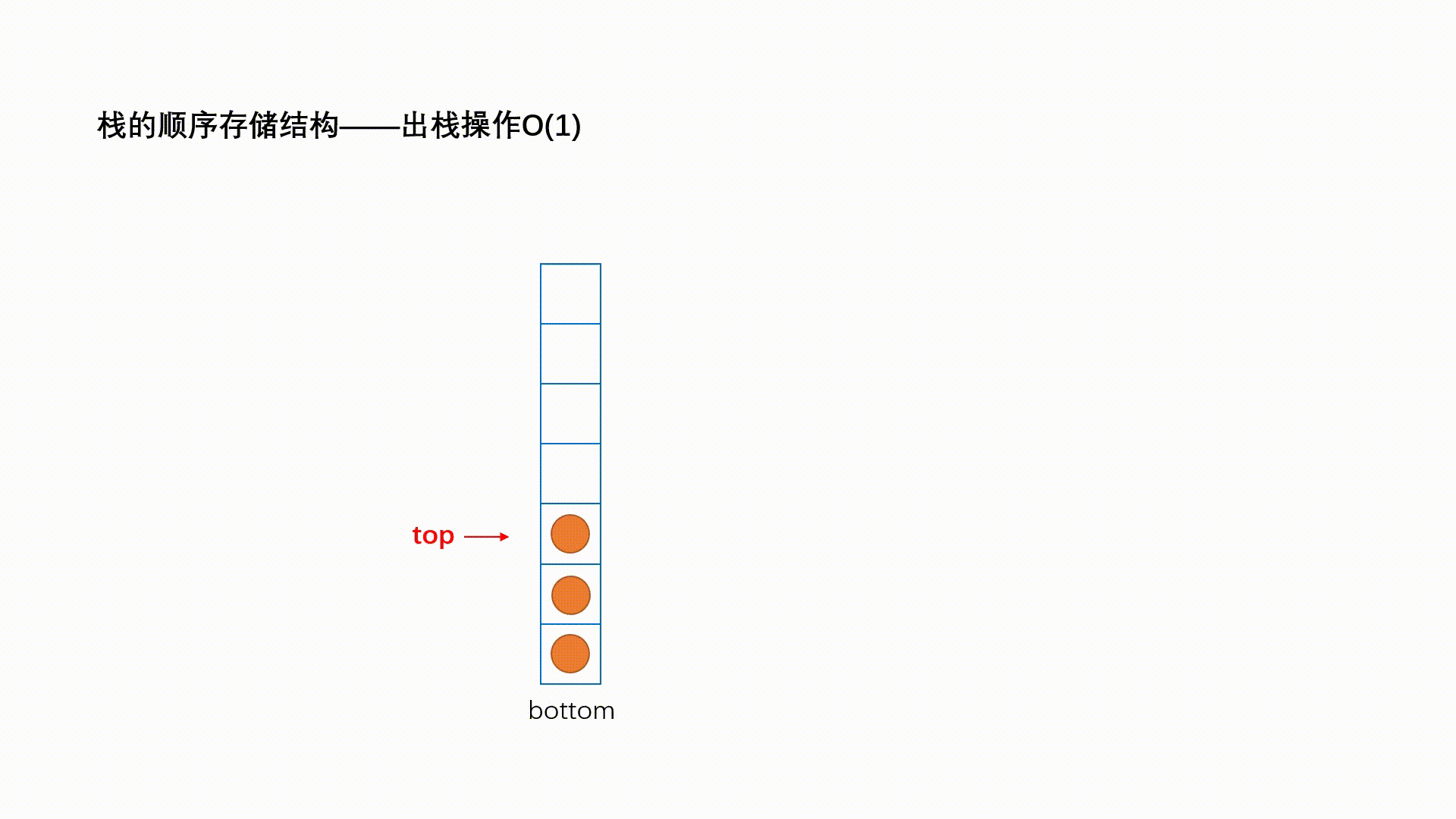
栈的实现
顺序栈
1
2
3
4
5
6
7
8
9
10
11
12
13
14
15
16
17
18
19
20
21
22
23
24
25
26
27
28
29
30
31
32
33
34
35
36
37
38
39
40
41
42
43
44
45
46
47
48
49
50
51
52
53
54
55
56
57
58
59
60
61
62
63
64
65
66
67
68
69
70
71
72
73
74
75
76
77
78
79
80
81
82
83
84
85
86
87
88
89
90
91
92
93
94
95
96
97
|
#include<stdio.h>
#include<stdlib.h>
#include<conio.h>
#define MAXSIZE 100
typedef struct stack
{
int data[MAXSIZE];
int top;
}SEQSTACK;
void initstack(SEQSTACK *s)
{
s->top=-1; ;
}
int empty(SEQSTACK *s)
{
if(s->top==-1)
return 1;
else
return 0;
}
void push(SEQSTACK *s,int x)
{
if(s->top==MAXSIZE-1)
printf("存储空间已满,元素进栈失败!\n");
else
{
s->top++; ;
s->data[s->top]=x; ;
}
}
int pop(SEQSTACK *s)
{
int e;
if(empty(s)==-1)
{
printf("栈中元素已空,出栈元素失败!\n");
return -99;
}
else
{
e=s->data[s->top]; ;
s->top--; ;
return e;
}
}
void conversion(SEQSTACK *s,int N,int r)
{
int x;
initstack(s);
while (N!=0)
{
push(s,N%r); ;
N=N/r; ;
}
while (!empty(s))
{
x=pop(s);
if(x==10)printf("A");
else if(x==11)printf("B");
else if(x==12)printf("C");
else if(x==13)printf("D");
else if(x==14)printf("E");
else if(x==15)printf("F");
else printf("%d",x);
}
printf("\n");
}
void main()
{
int number,r;
SEQSTACK stack;
char choice;
while(1)
{
printf("请输入一个十进制整数:");
scanf("%d",&number);
printf("选择将该数转换为几进制数(2,8,16):");
scanf("%d",&r);
fflush(stdin);
printf("转换后的结果为:");
conversion(&stack,number,r);
printf("是否继续?按N结束,其他任意键继续…");
scanf("%c",&choice);
system("cls");
if(choice=='N'||choice=='n')
break;
}
}
|
链栈
1
2
3
4
5
6
7
8
9
10
11
12
13
14
15
16
17
18
19
20
21
22
23
24
25
26
27
28
29
30
31
32
33
34
35
36
37
38
39
40
41
42
43
44
45
46
47
48
49
50
51
52
| #include<stdio.h>
#include<stdlib.h>
typedef struct LinkStack{
int data;
struct LinkStack *next;
}LStack;
LStack *CreateLStack(){
LStack *S;
S=(LStack*)malloc(sizeof(LStack));
if(S==NULL)
return S;
else{
S->next=NULL;
return S;
}
}
void LStack_Push(LStack *S,int item){
LStack *p,*r;
p=(LStack*)malloc(sizeof(LStack));
p->data=item;
p->next=S->next;
S->next=p;
}
int LStack_Pop(LStack *S,int item){
LStack *p;
p=S->next;
S->next=p->next;
item=p->data;
free(p);
return item;
}
int main()
{
LStack *S=CreateLStack();
if(S==NULL)
printf("申请空间失败");
int i,num,j;
printf("请输入个数");
scanf("%d",&i);
j=i;
for(i;i>=1;i--)
{
scanf("%d",&num);
LStack_Push(S,num);
}
printf("依次出栈\n");
for(j;j>=1;j--)
{
printf("%d\n",LStack_Pop(S,num));
}
return 0;
}
|
队列(Queue)
1.队列(Queue)是只允许在一端进行插入操作,而在另一端进行删除操作的线性表。允许插入的端是队尾,允许删除的端是队头。
2.队列是一个先进先出的线性表,相应的也有顺序存储和链式存储两种方式。
进队(PushQueue)和出队(PopQueue)
进队
- 将该数据元素用节点包裹,例如新节点名称为 elem;
- 与 rear 指针指向的节点建立逻辑关系,即执行 rear->next=elem;
- 最后移动 rear 指针指向该新节点,即 rear=elem;
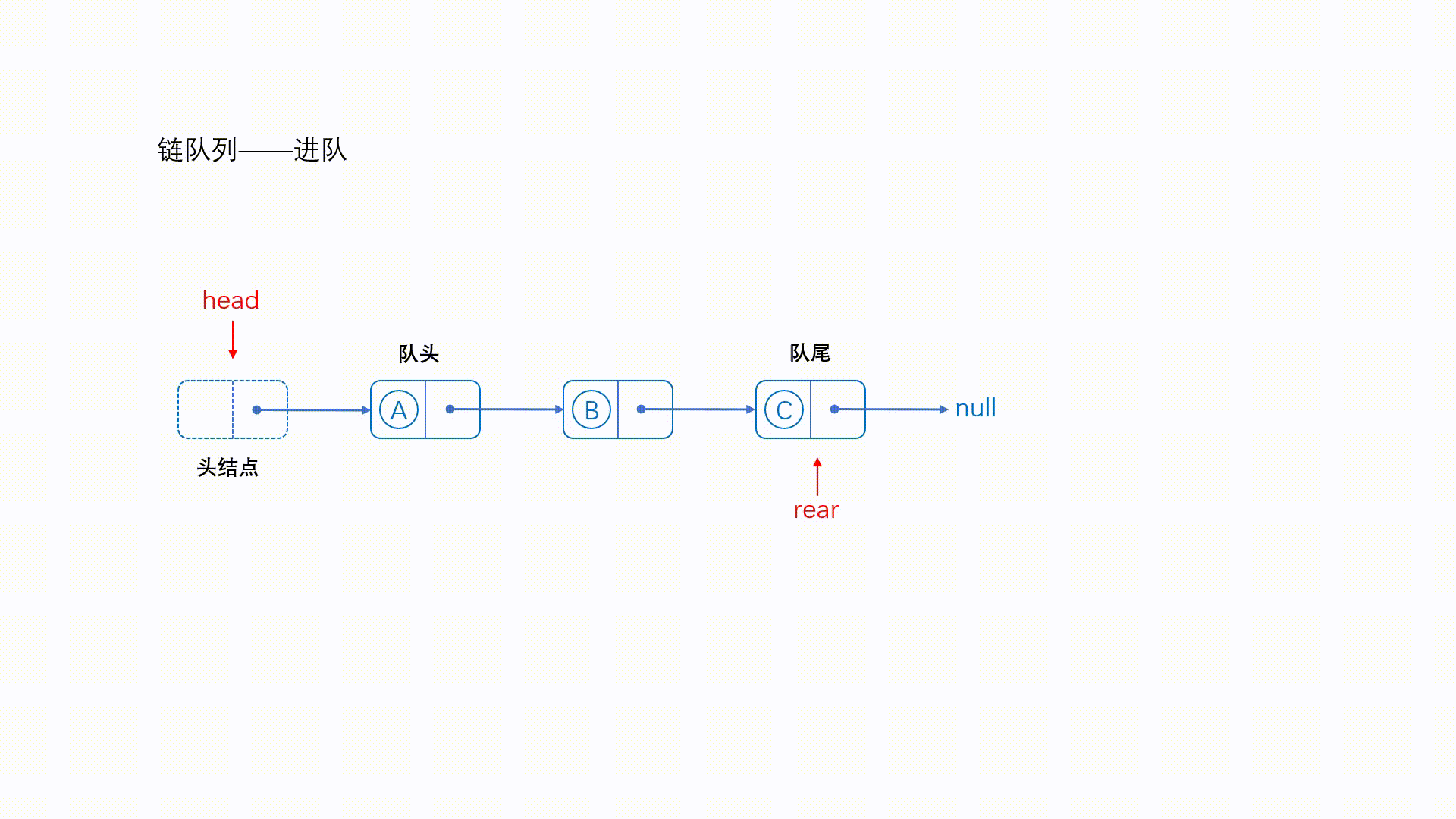
出队
- 通过 front 指针直接找到队头节点,创建一个新指针 p 指向此即将出队的节点;
- 将 p 节点(即要出队的队头节点)从链表中摘除;
- 释放节点 p,回收其所占的内存空间;
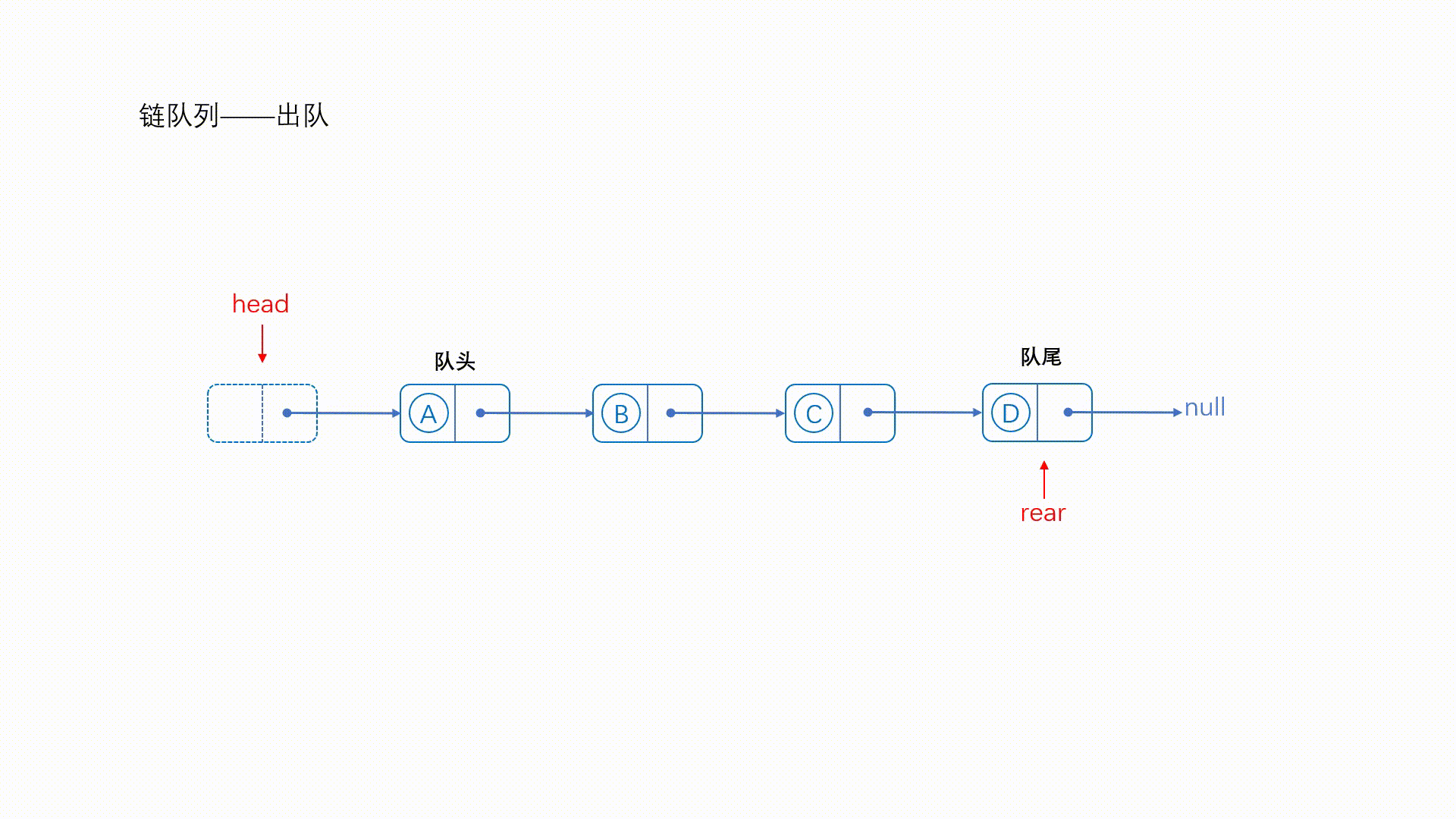
队列的实现
顺序队列
1
2
3
4
5
6
7
8
9
10
11
12
13
14
15
16
17
18
19
20
21
22
23
24
25
26
27
| #include <stdio.h>
int enQueue(int *a,int rear,int data){
a[rear]=data;
rear++;
return rear;
}
void deQueue(int *a,int front,int rear){
while (front!=rear) {
printf("出队元素:%d\n",a[front]);
front++;
}
}
int main() {
int a[100];
int front,rear;
front=rear=0;
rear=enQueue(a, rear, 1);
rear=enQueue(a, rear, 2);
rear=enQueue(a, rear, 3);
rear=enQueue(a, rear, 4);
deQueue(a, front, rear);
return 0;
}
|
链队列
1
2
3
4
5
6
7
8
9
10
11
12
13
14
15
16
17
18
19
20
21
22
23
24
25
26
27
28
29
30
31
32
33
34
35
36
37
38
39
40
41
42
43
44
45
46
47
48
49
50
51
52
53
54
55
56
57
58
59
60
61
62
63
64
65
66
67
68
69
70
71
72
73
74
75
76
77
78
79
80
81
82
83
84
85
86
87
88
89
90
91
92
93
94
95
96
97
98
99
100
101
102
103
104
105
106
107
108
109
|
#include<stdio.h>
#include<stdlib.h>
#include<conio.h>
typedef int elemtype;
typedef struct node //队列结点类型定义
{ elemtype data;
struct node *next;
}NODE;
typedef struct
{
NODE *front,*rear;
}LINKQUEUE;
void initqueue(LINKQUEUE *QL)
{
QL->front=(NODE *)malloc(sizeof(NODE));
QL->front->next=NULL;
QL->rear=QL->front;
}
LINKQUEUE *pushqueue(LINKQUEUE *QL,elemtype x)
{
NODE *p;
p=(NODE*)malloc(sizeof(NODE));
p->data=x;
p->next=NULL;
if(QL->rear==NULL){
QL->front=QL->rear=p;
}
else{
QL->rear->next=p;
QL->rear=p;
}
return QL;
}
elemtype popqueue(LINKQUEUE *QL)
{
NODE *t;
elemtype x;
t=QL->front;
if(QL->front==QL->rear)
return 0;
else
QL->front=QL->front->next;
x=t->next->data;
free(t);
return x;
}
void printqueue(LINKQUEUE *QL)
{
NODE *p;
p=QL->front->next;
if(p==NULL)
printf("队列空!");
while(p!=NULL)
{
if(p->next==NULL)
printf("%d",p->data);
else
printf("%d<--",p->data);
p=p->next;
}
printf("\n");
}
void main()
{
LINKQUEUE *p;
int choice,elemdata,x=0;
p=(LINKQUEUE *)malloc(sizeof(LINKQUEUE));
initqueue(p);
while(1)
{
printf(" 欢迎使用队列操作小程序:\n");
printf("\t1、元素入队\n");
printf("\t2、元素出队\n");
printf("\t3、显示队列\n");
printf("\t4、清屏幕\n");
printf("\t5、退出程序\n");
printf(" 请选择你的操作:");
scanf("%d",&choice);
switch(choice)
{
case 1:printf("请输入进队元素:");
scanf("%d",&elemdata);
p=pushqueue(p,elemdata);
printf("队列中的元素为:\n");
printqueue(p);
system("pause");
break;
case 2:x=popqueue(p);
if(x!=0)
printf("元素%d出队!\n",x);
printf("队列中的元素为:\n");
printqueue(p);
system("pause");
break;
case 3:printf("队列中的元素分别为:\n");
printqueue(p);
system("pause");
break;
case 4:system("cls");
break;
case 5:return;
}
system("cls");
}
}
|




